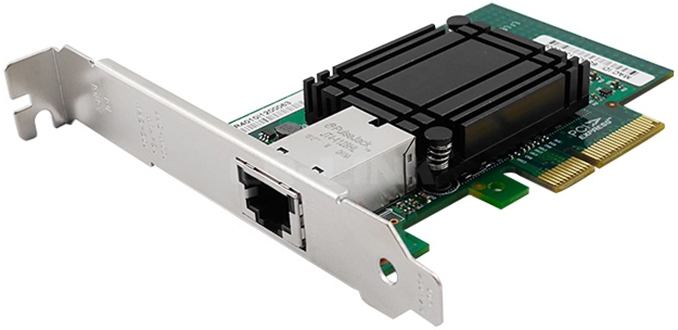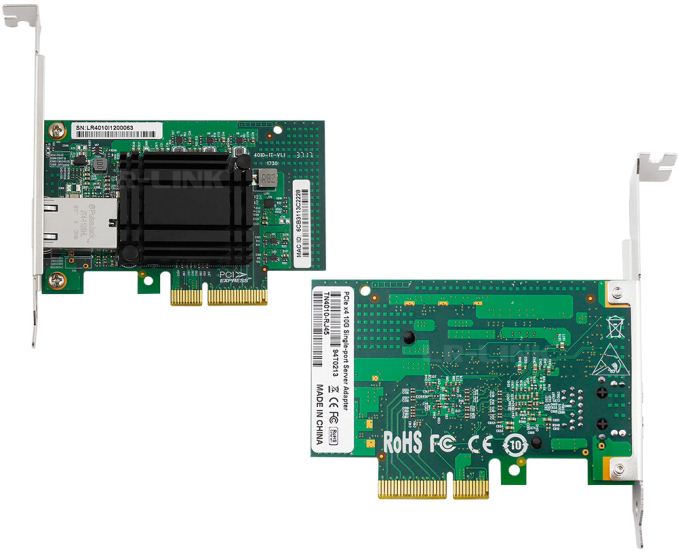LR-Link Launches New Mass-Market 10GigE NIC Based on Tehuti Networks’ Tech
by Anton Shilov on August 9, 2018 5:00 PM EST- Posted in
- Networking
- Marvell
- 10G Ethernet
- 10GBase-T
- Tehuti
- 10GbE
- LR-Link

LR-Link, a maker of networking solutions from China, has announced its first 10 GbE NIC, the wordy-named LREC6860BT. The new NIC is the first such retail product we've seen based on a design from Tehuti Networks, an Israel-based developer, bringing some more welcome competition to the 10GigE NIC market. LR-Link will be aiming at the (relative) mass-market for standalone NICs with this card, with the card now selling in Japan as well as online for less than $100.
Under the hood, the LR-Link LREC6860BT NIC is based on Tehuti Networks’ TN4010 MAC, which is further paired with Marvell’s Alaska X 88X3310P 10 GbE transceiver. The card features a PCIe Gen 2 x4 interface as well as an RJ45 connector that supports 100M, 1G, 2.5G, 5G, and 10G speeds using Cat5e/Cat6/Cat6A cabling. The card fully supports contemporary operating systems from Apple, Microsoft, and VMware as well as various Linux distributives. Therefore, the NIC is drop-in compatible with most computers that are in use today.
| LR-Link's 10 GbE NIC | ||
| LREC6860BT | ||
| Silicon | MAC | Tehuti Networks TN4010 |
| Transceiver | Marvell Alaska X 88X3310P | |
| 100BASE-T | Yes | |
| 1000BASE-T | Yes | |
| 2.5GBASE-T | Yes | |
| 5GBASE-T | Yes | |
| 10GBASE-T | Yes (over Cat6A cables) | |
| Ports | 1 | |
| OS Compatibility | Apple | MacOS 10.10.3 or later |
| Microsoft | Windows 7 / 8 / 8.1 / 10 or later Windows Server 2008 R2 / 2012 / 2012 R2 / 2016 R2 or later |
|
| VMware | Vmware ESX / ESXi 5.x / 6.x or later | |
| Linux | Linux Stable Kernel version 2.6.x/3.x or later | |
| Price | $83 - $91 | |
| Release Date | Q3 2018 | |
| Additional Information | Link | |
The LREC6860BT is currently available from at least one retailer in Japan for ¥10,164 ($91) with VAT, which is not very high considering the fact that PC components tend to cost more in Japan than in the rest of the world. Unfortunately products from LR-Link aren't readily available from retailers outside China and Japan, but the company’s devices (including the 10 GbE NIC) can still be purchased from official stores on AliExpress, Ebay, and JD.com.
10 GbE networks are not yet widespread in SOHO environments, primarily because there are not many reasonably-priced 10 GbE switches. Meanwhile, a number of companies have released their relatively affordable 10 GbE NICs based on chips from Aquantia over the past few quarters, anticipating demand for such cards from enthusiasts. Aquantia is not the only provider of solutions for inexpensive 10 GbE cards. Tehuti Networks is considerably less known because it is focused on working with enterprise OEMs rather than with AIBs and retail. Nonetheless, having a second player in the space for cheap 10GigE/NBASE-T silicon is an important part of driving down the cost of the technology –and boosting adoption – even further.
Related Reading:
- AKiTiO’s Thunder3 10G Adapter Now Available: TB3-to-10GbE for Sub-$300
- Aquantia’s Gamer Edition AQtion AQN-107 10 GbE NIC Available
- Aquantia to Sell Its 5G and 10G Network Cards for $59 and $69 on Black Friday
- ASUS Launches XG-C100C 10 GBase-T Adapter: Aquantia AQC107, $99
- GIGABYTE’s GC-AQC107 10G Ethernet PCIe Card Launched and Listed
Source: PC Watch











46 Comments
View All Comments
ajp_anton - Friday, August 10, 2018 - link
Been waiting for these, but my pfSense box isn't upgradable, so I'd have to replace the whole thing. My ISP offers 10Gbit internet, but I have no hardware to take advantage of it yet.LordConrad - Friday, August 10, 2018 - link
I'm using a Netgear GS110EMX with two Aquantia cards and the speed is excellent. I only need 10G Ethernet between two machines, the rest are single or teamed Gigabit connections. I went with the Netgear after hearing about problems with Asus consumer 10Gb switch, and I'm glad i did.abufrejoval - Saturday, August 11, 2018 - link
I've had my first Asus switch 'die' on me (the port would no longer work at 10Gbit, auto-negotiation failed, but *would* function when I configured the NIC for 1Gbit) and I attributed that to the fact that I was using an older 10GBase-T NIC from Intel that uses a full 10 Watts on the PHY, where the Aquantias will typically try 'greener' 3 Watts from what I read.Had it swapped without problems by the e-tailer and have not tried the Intel NICs since, because they do generate quite a bit of heat and are actually designed for server airflow. Same with BroadComs I had, two of those actually died in my tower chassis, because the air-flow wasn't good enough for the 20Watts a dual port NIC could burn on PHY alone.
The Asus switch does get pretty warm even with the low power Aquantia NICs connected (and all 1Gbit ports in full action), but zero noise is rather more compelling than the risk of having to buy another in two years.
SultanFaris - Saturday, August 11, 2018 - link
Good Information and is very useful.mode_13h - Monday, August 13, 2018 - link
Please inquire how much power this actually burns @ 10 Gbps.Although, the bigger issue will be switches, as others already mentioned.
The MaD HaCkER - Sunday, September 8, 2019 - link
You are early adopters. The first to jump with one of those new parachute thingy’s. We all want to follow... As soon as we see if/how it works out. ;)